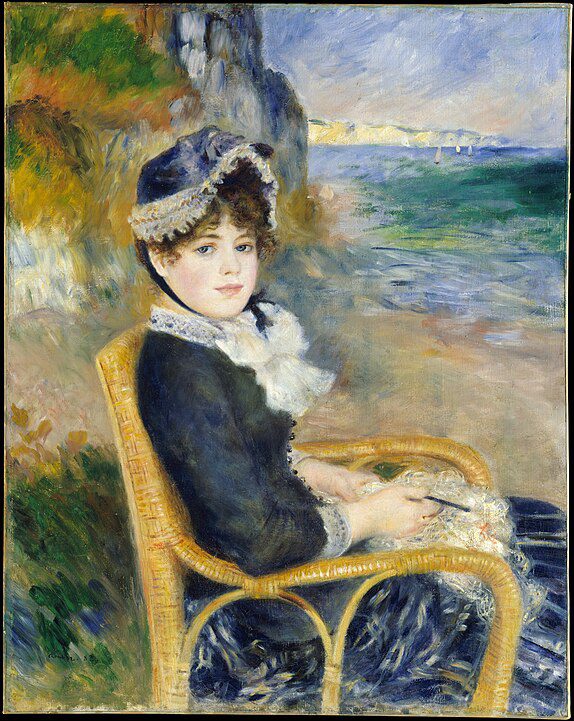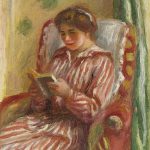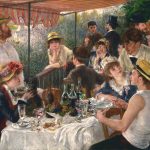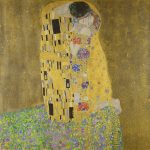
Pierre-Auguste Renoir, one of the most celebrated painters of the Impressionist movement, had a life deeply intertwined with his art. Central to his journey was Aline Charigot, who became his wife and a frequent model. Their relationship was not just a personal bond but also a professional partnership that significantly influenced Renoir’s work. Aline’s presence in his life and art offers us a glimpse into the intimate world of one of France’s most beloved artists.
Renoir met Aline Charigot in 1880 when she was just 20 years old, and he was already an established artist. Their meeting marked the beginning of a lifelong relationship that would culminate in marriage in 1890. But, even before they tied the knot, Aline played a crucial role in Renoir’s life. She was more than just his muse; she was his confidante and partner in many ways.
From the moment they met, Aline’s influence on Renoir’s work was undeniable. She appeared in several of his most famous paintings, often depicted with a warmth and affection that was absent in his other works. Aline was not just a subject to be painted; she was someone who brought out the softer, more tender side of Renoir’s artistry. Their relationship was one of mutual respect and admiration, something that was reflected in the way Renoir painted her.
Moreover, Renoir’s art during this period began to reflect a more intimate and personal tone, thanks in part to Aline’s influence. She brought stability and comfort to his life, which in turn allowed him to focus more deeply on his art. As a result, some of Renoir’s most iconic works from the 1880s and 1890s feature Aline as the central figure, capturing the essence of their love and partnership.
Aline as the Muse
Aline Charigot’s role as Renoir’s muse cannot be overstated. She was the inspiration behind some of his most famous paintings, and her presence in his life helped to shape his artistic vision. Renoir’s paintings of Aline are characterized by their warmth, tenderness, and affection, which were evident in works like “Luncheon of the Boating Party” and “The Umbrellas.”
In “Luncheon of the Boating Party,” Aline is the woman in the foreground holding a small dog, gazing affectionately at the viewer. This painting is one of Renoir’s most famous works, capturing the vibrant social life of Parisian society. However, it is Aline’s presence in the painting that adds a layer of intimacy and warmth, making it one of Renoir’s most beloved pieces.
Similarly, in “The Umbrellas,” Aline is featured as a central figure, her delicate features and serene expression drawing the viewer’s eye. Renoir’s depiction of Aline in this painting is a testament to his skill as an artist, capturing not just her physical beauty but also the calm and gentle spirit that she brought into his life. Her influence on his work was profound, shaping the way he approached portraiture and the depiction of women in his art.
Aline’s role as Renoir’s muse was not limited to just a few paintings. She was a constant presence in his life and art, appearing in numerous works over the years. Her influence extended beyond her physical appearance; she inspired Renoir to explore new themes and styles, pushing the boundaries of his artistry. Their relationship was a true collaboration, with Aline playing a pivotal role in Renoir’s creative process.
Aline’s Impact on Renoir’s Style
As Renoir’s muse, Aline Charigot had a significant impact on his artistic style. Before meeting Aline, Renoir’s work was characterized by its focus on light, color, and movement, hallmarks of the Impressionist movement. However, after Aline entered his life, Renoir’s style began to evolve, reflecting a deeper emotional connection to his subjects.
Renoir’s paintings of Aline are marked by their softness and warmth, qualities that were not as prominent in his earlier works. Her presence in his life brought out a more intimate side of Renoir’s artistry, leading him to create works that were not just visually stunning but also emotionally resonant. This shift in style was evident in the way Renoir began to use color and light, with a greater emphasis on creating a sense of warmth and intimacy in his paintings.
Moreover, Aline’s influence on Renoir’s style extended to his depiction of women. Before Aline, Renoir’s portrayals of women were often idealized, focusing on their beauty and grace. However, after Aline became his muse, Renoir’s depictions of women became more realistic and nuanced, capturing the complexity of their emotions and personalities. Aline’s presence in his life allowed Renoir to see women in a new light, leading to a more empathetic and realistic portrayal of his female subjects.
In addition, Renoir’s color palette began to change after meeting Aline. His earlier works were often characterized by their vibrant, contrasting colors, but after Aline entered his life, Renoir began to use softer, more harmonious tones. This shift in color palette reflected the influence of Aline’s gentle and calming presence in Renoir’s life, leading to a more serene and peaceful quality in his work.
The Influence of Aline’s Background
Aline Charigot came from a humble background, which played a significant role in shaping her relationship with Renoir and, by extension, his art. Born in a small village in France, Aline was not part of the bourgeois circles that Renoir often painted. Her simplicity and down-to-earth nature provided Renoir with a different perspective on life, one that was less concerned with the frivolities of high society and more focused on the simple pleasures of everyday life.
Aline’s background influenced Renoir’s work in several ways. First, it brought a sense of authenticity to his paintings. Unlike many of the other women Renoir painted, who often came from the upper echelons of society, Aline represented the everywoman. Her presence in Renoir’s work added a layer of relatability and realism that was often missing in his earlier works. This shift in focus allowed Renoir to connect with a broader audience, as his paintings began to reflect the experiences of ordinary people.
Moreover, Aline’s background influenced the themes that Renoir explored in his work. Before meeting Aline, Renoir’s paintings often depicted the glamorous and luxurious lifestyles of the Parisian elite. However, after Aline entered his life, Renoir began to explore themes of domesticity and family life, reflecting the influence of Aline’s humble upbringing. This shift in subject matter allowed Renoir to create works that were more personal and intimate, capturing the beauty of everyday life.
In addition, Aline’s influence can be seen in the way Renoir approached his art. Her simplicity and practicality helped to ground Renoir, allowing him to focus on the essentials of his craft. Aline’s presence in his life provided Renoir with the stability and support he needed to continue creating, even during the most challenging times. Her influence was a constant source of inspiration for Renoir, shaping his work in ways that were both subtle and profound.
Marriage and Family Life
When Renoir and Aline married in 1890, their relationship took on a new dimension. Their marriage marked the beginning of a period in Renoir’s life that was characterized by stability and contentment, qualities that were reflected in his art. The couple had three sons together: Pierre, Jean, and Claude, and family life became a central theme in Renoir’s work.
Renoir’s paintings from this period often depict scenes of domesticity, with Aline and their children serving as his primary subjects. These works are characterized by their warmth and intimacy, capturing the joy and contentment that Renoir found in his family life. Paintings like “The Artist’s Family” and “Mother and Children” showcase Renoir’s ability to capture the tender moments of family life, with Aline often depicted as the nurturing and loving mother.
Moreover, Aline’s role in Renoir’s life extended beyond just being his wife and muse. She also played a crucial role in managing their household, providing Renoir with the stability he needed to focus on his art. Aline’s practical nature and strong work ethic allowed Renoir to continue painting without having to worry about the day-to-day challenges of running a household. This support was essential to Renoir’s success as an artist, allowing him to create some of his most iconic works during this period.
Their family life was not without its challenges, however. Renoir suffered from rheumatoid arthritis in his later years, which made it difficult for him to paint. Despite this, Aline remained by his side, providing the care and support he needed to continue working. Her dedication to Renoir and their family was unwavering, and it was this steadfast support that allowed Renoir to continue creating art until the end of his life.
Aline’s Role in Renoir’s Later Years
As Renoir aged, his health began to decline, but his passion for painting never waned. Aline played a crucial role in supporting Renoir during this difficult period, both emotionally and physically. Her unwavering dedication to her husband allowed him to continue working despite the challenges he faced.
Renoir’s rheumatoid arthritis severely limited his mobility, making it difficult for him to hold a paintbrush. However, with Aline’s help, Renoir was able to continue painting. She would often assist him in setting up his easel and brushes, ensuring that he had everything he needed to work. Aline’s support during this time was invaluable, allowing Renoir to maintain his artistic practice even as his body failed him.
Moreover, Aline’s presence in Renoir’s life provided him with the emotional strength he needed to continue creating. Despite the physical pain and limitations he faced, Renoir never lost his passion for art, largely thanks to Aline’s encouragement and support. Her love and dedication gave Renoir the strength to persevere, allowing him to create some of his most powerful and moving works during this period.
In addition to her role as Renoir’s caregiver, Aline continued to serve as his muse. Even in his later years, Renoir continued to paint Aline, capturing her essence with the same warmth and tenderness that characterized his earlier works. These paintings are a testament to the deep love and admiration that Renoir felt for Aline, as well as her enduring influence on his art.
Aline’s Legacy
Aline Charigot’s influence on Pierre-Auguste Renoir’s work is undeniable. As his wife, muse, and partner, she played a central role in shaping his artistic vision and style. Her presence in his life provided Renoir with the inspiration and support he needed to create some of his most iconic works, and her legacy lives on in the paintings that continue to captivate audiences today.
Aline’s influence on Renoir’s work can be seen in the way he depicted women. Her presence in his life allowed Renoir to see women in a new light, leading to a more empathetic and realistic portrayal of his female subjects. Aline’s impact on Renoir’s art was not just limited to her physical appearance; she also inspired him to explore new themes and styles, pushing the boundaries of his artistry.
Moreover, Aline’s legacy extends beyond her role as Renoir’s muse. As his wife and partner, she played a crucial role in supporting Renoir throughout his career, providing him with the stability and encouragement he needed to continue creating. Her dedication to her husband and their family allowed Renoir to focus on his art, leading to the creation of some of his most beloved works.
Today, Aline Charigot’s legacy lives on in the paintings that bear her image, as well as in the influence she had on Renoir’s work. Her presence in his life was a source of inspiration and comfort, shaping his art in ways that continue to resonate with audiences around the world. Aline’s influence on Renoir’s work is a testament to the power of love and partnership, and her legacy will continue to be celebrated for generations to come.
Conclusion
Pierre-Auguste Renoir and Aline Charigot shared a bond that transcended the typical relationship between artist and muse. Their partnership was one of mutual respect, love, and admiration, qualities that were reflected in the art Renoir created during their time together. Aline’s influence on Renoir’s work was profound, shaping his artistic vision and style in ways that continue to be celebrated today.
Renoir’s paintings of Aline capture the essence of their relationship, reflecting the warmth, tenderness, and intimacy that characterized their life together. Aline’s role as Renoir’s muse was more than just a source of inspiration; she was a central figure in his life, providing the support and stability he needed to continue creating art. Her legacy lives on in the works that bear her image, as well as in the influence she had on Renoir’s art.
In the end, Aline Charigot’s impact on Pierre-Auguste Renoir’s life and work cannot be overstated. She was more than just his wife and muse; she was his partner, confidante, and source of inspiration. Together, they created a body of work that continues to captivate and inspire audiences around the world, ensuring that their legacy will endure for generations to come.




